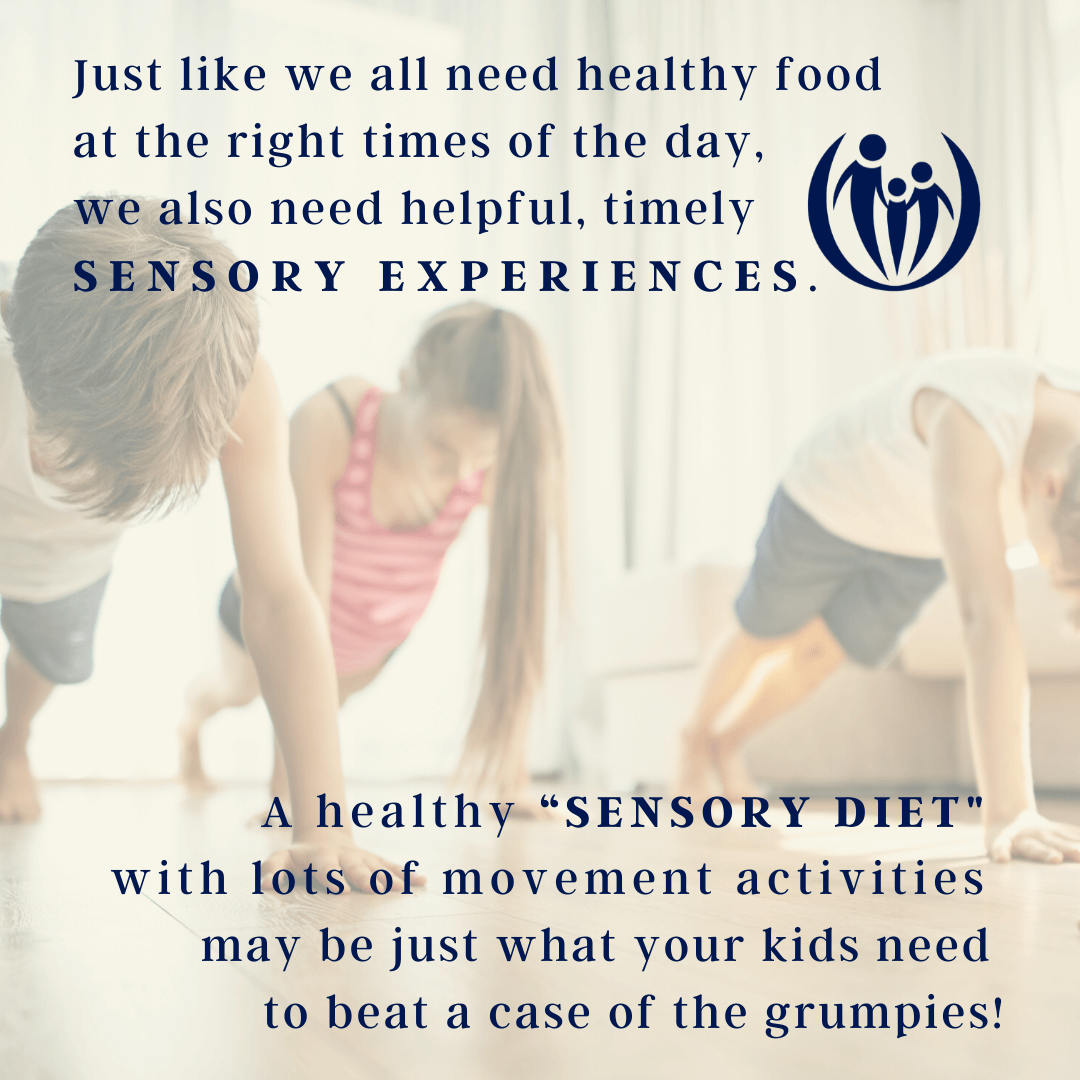
How to Create a Simple Sensory Diet for Restless, Homebound Kids | Ep. 30

Are you “walking on eggshells” with restless, homebound kids? Do your kids have a case of “Grumpy Child Syndrome”? Your family may need an extra dose of a healthy sensory diet. What is a sensory diet? Why is it important? And how can you incorporate it in practical ways with your kids? Read on. (This article is also available as a video or audio download.)
In the midst of stressful times, we may find ourselves encountering grumpy kids. (We may even admit to experiencing some grumpy feelings of our own!) There is nothing wrong with you or your kids.
Just like our bodies need healthy food at the right times of the day so we don’t get “hangry,” we also need healthy, timely sensory experiences. Everyone’s body needs healthy movement to help improve mood! Feelings of grumpiness and restlessness in our kids could be signaling the need for a more balanced sensory diet.
What is a sensory diet?
A sensory diet is the purposeful use of sensory and movement activities at key times of the day (along with quiet times strategically interspersed) to make it easier to naturally regulate energy and emotions. Big muscle play is especially important for a sensory diet.
Why is a sensory diet important?
When we’re upset, our brains trigger the release of fight or flight neurotransmitters to get us ready to “slug or run” in self-protection. The blood flows away from our frontal lobe and goes to our big muscles.
If that body chemistry isn’t used for its intended purpose of big muscle action, it stays in a person’s system and creates an ongoing sense that something’s wrong. And, when a child’s nervous system is on edge, it doesn’t take much to trigger an aggressive or defensive reaction.
What’s the answer? Play! When placed in a tense situation, play-deprived rats were either aggressive or ran away to a corner. Remarkably, an hour of play a day offsets this tendency. There’s evidence this is also true for humans!
Knowing this about rats, it’s no wonder why cooped-up kids are so irritable…
Big muscle play uses up those fight/flight neurotransmitters and increases serotonin, the feel-good hormone that kids are often low on. Sensory activities can increase serotonin and improve mood!
How does a sensory diet work?
Just like we need good food at times of hunger, look for the typical times of day that kids might get edgy out of “sensory hunger.” Shortly before that time offer some sensory activities. Consider interspersing “recess” at scheduled times of the school work day, especially before tackling a difficult subject.
Another typical “sensory hungry” time is late afternoon or right before dinner. Your child could use a hop ball to bring the napkins to the dinner table one at a time, an activity that has helped numerous kids sit better at dinner.
If you have kids that get riled up with big muscle play, a key to an effective sensory diet can be making sure activities are rhythmical and purposeful rather than wild and chaotic. Provide structure and repetition, using obstacle courses, bear walk or crab walk relays, music and movement activities, or bike rides if those are an option.

Get creative with sensory materials at home
One mom was struggling with her son and his math. She gave him the idea to slide down the stairs in a sleeping bag, climb back up and do it again. And again. Structured, repetitive climbing and bumping! He went from being testy and cranky, to happy and cooperative! This particular kind of movement had given his body and brain the sensory input it needed to be calm and focused for his schoolwork.
One family recently got a trampoline* for the backyard to deal with the growing “cooped up” restlessness they were seeing. Jumping on the trampoline brought dramatic changes to one son’s behavior and outbursts. The mom declared, “My boy is back. He has been full of joy. All the angsty moments, arguments with siblings, and hiding in his room have stopped.” (She also told me she was loving the trampoline as well!)
We can help our kids diminish their stress and increase their joy with the right kind of movement!
Practical activities to help your restless kids
The key to helping our kids become more regulated is to be encouraging and intentional in setting them up for regular sensory activities. It’s important to be inviting, not demanding, and join in the fun as much as possible. Whatever activity you choose to do, be sure to help kids write safety rules for all new equipment before using.
There are many practical ways to incorporate a sensory diet:
- Climbing. Hide things on opposite levels of the house and give clues to get kids to climb up and down the stairs. Or use a doorway swing hanger and attach a playset suspended ladder. Clip a bucket at the top, and put puzzle or Lego pieces in the bucket for kids to retrieve one at a time.
- Jump and crash. Put a mattress on the floor (maybe even store your child’s bed frame) and pile it with pillows. Give your child a step stool or chair to climb up on and then jump.
- Create an obstacle course with household objects.
- Hopball. Relive your childhood!
- Doorway swing hanger with a calming mesh swing or inner tube swing.
- Massage therapy and pressure activities. Deep pressure back rubs and squeezes increase serotonin and decrease stress hormones.
- Kids movement videos on YouTube.
- Play wrestling.
- Sunshine! Being in the sun boosts serotonin levels. Sunlight, even on cloudy days, is far brighter than indoor light.
- Play tents filled with pillows and stuffed animals can give needed quiet rest away from the commotion.
- Create a martial arts studio…in your house!
- Do you have a toddler? Here are some great ideas for using household items!
- For a complete list of fun activities see 60 Ways to Get Kids Moving and Laughing.
Reframe tense situations with compassion
Remember this as you seek to help your family through difficult times: reframe tense situations with compassion. “Grumpy” is not your child’s identity.
God made you and your child for good things and for His purposes. In the midst of our daily struggles, we may feel misaligned from God’s purposes. We can reframe our situation with grace for our kids and ourselves.
We would love to hear your stories! How have these sensory activities helped your family? What new activities have you found to bring calm and regulation to restless kids?
Please let us know how we can pray for you and continue to come alongside you during this time. We are here for you, and we are praying for you! Email your prayer requests to info@connectedfamilies.org.
*If you choose to allow your children to jump on a trampoline, please remember to follow the guidelines and take safety precautions.
© 2020 Connected Families
Does your child need help calming down?
Would a free course presenting you 7 sensory strategies to calm your child be useful?
If yes, take our FREE online course 7 Practical Calming Strategies for Kids.
Related Posts
Podcast: Play in new window | Download | Embed








